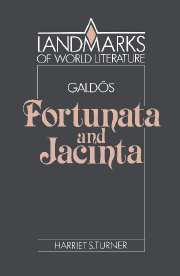Book contents
1 - Social and historical contexts of a changing world
Published online by Cambridge University Press: 18 December 2009
Summary
History, politics and private life
The events of Fortunata and Jacinta take place some fifteen years prior to the time of writing and publication, from September 1869, when Juanito first meets Fortunata, to her death in late April 1876. The ancestry of the Santa Cruz family reaches back to the eighteenth century and beyond, originating in a primal blood-tie between female cousins of the Castilian Trujillo clan. The matriarchal line establishes the trunk of the great family tree, while matriarchy and monarchy, alternating with the Republic, determine a reciprocity between history, politics and private life. The alternations correspond to the pervasive, acute state of imbalance that marked Spain's emergence into the modern period, dated approximately from the Napoleonic invasion in 1808, followed by the “liberal codex” of the Constitution of Cádiz of 1812. A constitutional system was maintained during the periods 1834–68 and 1875 – 1923, alternating with periods of absolutism and revolution and culminating in the Spanish Civil War (1936–39).
Following the enlightenment and reforms accomplished during the reign of Charles III (1759–88), the nineteenth century in Spain saw, among other conflicts, a sporadic civil war between Carlist factions and the central government in Madrid. Carlism, first as a factious group, then as a military insurgency led by Ferdinand VII's younger brother, maintained divisions throughout the country. Almost a decade (1856–63) of stability was gained by the Unión Liberal government of Leopoldo O'Donnell, which, supported by a new prosperity, encouraged foreign investment and expanded the railway system.
- Type
- Chapter
- Information
- Galdós: Fortunata and Jacinta , pp. 18 - 49Publisher: Cambridge University PressPrint publication year: 1992

